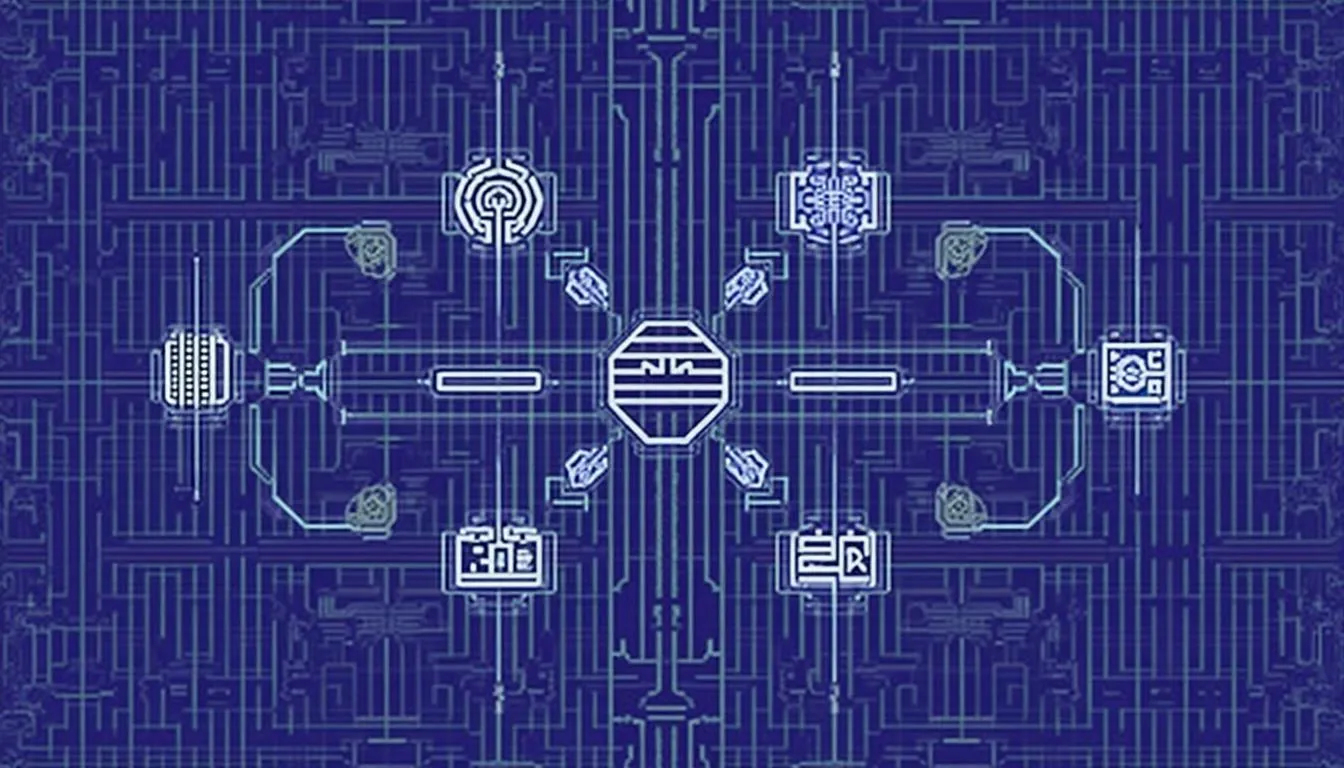
Did you know that the decentralized internet, often dubbed “Web 3.0,” is poised to revolutionize how we interact online? One of its most promising components is Depin, a concept that’s rapidly gaining traction in tech circles.
Depin stands for Decentralized Physical Infrastructure Networks. Unlike traditional networks reliant on centralized entities, Depin leverages blockchain technology to create more secure and efficient systems. It’s a game-changer for industries looking to enhance transparency and reduce costs.
If you’re someone who’s been grappling with issues like data security or high operational expenses, Depin offers a compelling solution. Decentralizing infrastructure addresses these pain points head-on, providing a more resilient and cost-effective alternative.
I first encountered Depin while exploring applications of blockchain at a conference. The potential was clear—imagine reducing downtime and boosting security without being very costly!
In this article, I’ll jump into how Depin works, its benefits, and why it’s set to reshape our digital future. For an in-depth look at blockchain’s broader impact, read more of our different guides.
Overview of Depin
Depin, or Decentralized Physical Infrastructure Networks, represents a transformative technology in the world of Web 3.0. It leverages blockchain to create decentralized networks that are more secure and efficient than traditional centralized systems.
Blockchain Basics for Depin
Blockchain is the backbone of Depin. Imagine an online ledger that’s shared across multiple locations instead of stored in one place. Each entry is a “block,” linked together in a “chain.” This setup ensures data integrity because altering one block affects all subsequent blocks, making tampering nearly impossible.
Real-World Applications
- Supply Chain Management: Companies use blockchain to track products from production to delivery. For example, Walmart uses blockchain to trace food items’ origins and ensure safety.
- Healthcare Records: Blockchain secures patient records, allowing authorized access while safeguarding privacy. Hospitals can share up-to-date information without compromising security.
Benefits for Beginners
For those new to blockchain: it’s not just about cryptocurrency. It’s about enhancing transparency and reducing costs. Depin offers these advantages by decentralizing physical infrastructure like servers and storage facilities.
Actionable Tips
- Start Small: Begin with understanding basic concepts through resources like Blockchain Basics.
- Use Tools: Platforms like Ethereum offer sandbox environments where you can experiment with smart contracts.
- Join Communities: Engage with blockchain forums on Reddit or join local meetups to learn from others’ experiences.
Encouragement for Further Exploration
Delving into Depin opens doors to numerous opportunities in tech innovation and efficiency improvements across industries. Explore further how this technology can revolutionize your business operations or personal endeavors by diving deeper into educational resources and community discussions.
Key Features of Depin
Depin, or Decentralized Physical Infrastructure Networks, stands out with its unique features. These features enhance security and efficiency in various industries.
Design and Build Quality
Depin’s design prioritizes decentralization to ensure no single point of failure exists. Blockchain technology underpins this structure, distributing data across multiple nodes for redundancy. This approach markedly reduces the risk of hacking compared to centralized systems. For instance, in supply chain management, companies like Walmart use blockchain to trace food origins seamlessly and securely.
The build quality of Depin is robust due to its decentralized nature. Each node operates independently yet contributes to the network’s overall integrity. This feature enables continuous operation even if some nodes fail or go offline temporarily. So, users benefit from a more resilient infrastructure capable of withstanding disruptions.
Performance
Depin delivers impressive performance by leveraging blockchain technology for faster transaction processing and verification. Traditional centralized networks often suffer from bottlenecks during peak usage times; but, Depin’s decentralized structure distributes the load evenly across nodes. This ensures consistent performance without slowdowns.
In healthcare, for example, patient records can be securely accessed and updated in real-time using blockchain-based systems within Depin frameworks while maintaining high-speed operations. This capability not only improves efficiency but also enhances data accuracy and accessibility for authorized personnel.
Battery Life
Battery life refers metaphorically here to the sustainability and longevity of Depin networks rather than physical battery power. Thanks to their decentralized nature, these networks exhibit significant durability over time as they rely on collective maintenance by multiple nodes rather than depending on a central authority for upkeep.
User Experience
Depin offers a seamless experience for users, prioritizing ease of use and intuitive design. By focusing on user-centric features, Depin ensures that even beginners can navigate its decentralized infrastructure effortlessly.
Usability
Depin’s usability centers around simplicity and accessibility. Users find it straightforward to set up and manage nodes without needing extensive technical knowledge. For example, platforms like Helium allow anyone to deploy a network hotspot with minimal setup time. This democratizes the infrastructure, making it accessible to hobbyists and professionals alike.
A key aspect is the integration of automated maintenance protocols that reduce manual intervention. This means the system handles most updates and troubleshooting automatically, freeing users from constant monitoring. Also, comprehensive online tutorials guide users through each step, ensuring they feel confident in managing their networks.
Interface
The interface of Depin platforms focuses on clarity and user-friendliness. Dashboards provide real-time data visualization, helping users track performance metrics easily. For instance, Ethereum-based applications often feature clean interfaces where users can view transaction histories and node statuses at a glance.
Interactive elements like drag-and-drop functionalities simplify complex tasks such as configuring smart contracts or adjusting network settings. The inclusion of customizable widgets lets users tailor their dashboard according to specific needs, enhancing overall efficiency.
By maintaining a balance between functionality and simplicity, Depin’s interface ensures an optimal user experience for everyone from blockchain novices to seasoned experts.
Pros and Cons
Understanding Depin’s benefits and drawbacks is essential for anyone considering its adoption. Here, I’ll outline the key points to help you make a well-informed choice.
Advantages of Depin
Depin enhances security by decentralizing data storage. Unlike centralized systems vulnerable to single-point failures, Depin distributes data across multiple nodes. This makes it harder for hackers to target.
Cost savings are significant with Depin. Traditional infrastructure involves high operational costs due to maintenance and updates. Depin leverages blockchain technology, reducing these expenses through automated processes.
Scalability is another strong suit of Depin. As more nodes join the network, its capacity increases without compromising performance. For instance, in supply chain management, companies can easily add new partners or products without overhauling the entire system.
Real-world applications show Depin’s versatility. In healthcare, it secures patient records while allowing authorized access only. Platforms like Helium make setting up and managing nodes straightforward even for beginners.
Disadvantages of Depin
But, there are challenges too. Initial setup costs can be high since deploying a decentralized network requires specialized hardware and software configurations.
Technical expertise may pose a barrier for some users. Although platforms aim for user-friendliness, a basic understanding of blockchain technology remains necessary for effective implementation.
Regulatory uncertainties also affect Depin adoption. Different countries have varying regulations concerning blockchain usage which could complicate compliance efforts.
Network speed might be inconsistent during peak times if not managed properly since decentralized networks rely on multiple nodes’ performance levels which could vary based on their locations or capabilities.
By weighing these pros and cons carefully, you’ll better understand whether adopting Depin aligns with your needs and goals.
Comparison with Competitors
Understanding how Depin stacks up against competitors helps clarify its unique benefits and potential drawbacks.
Depin vs. Competitor A
Depin prioritizes decentralization, enhancing security by eliminating single points of failure. In contrast, Competitor A focuses on hybrid models that combine centralized control with decentralized features. While this approach might streamline management, it introduces vulnerabilities associated with traditional systems.
Consider data integrity. Depin’s blockchain ensures tamper-proof records across all nodes. Competitor A may offer faster initial deployment but risks central authority manipulation or single-point breaches. For example, in healthcare, Depin can maintain consistent patient record security even during peak times when some nodes might fail.
For those new to blockchain, setting up a node on Depin is straightforward thanks to user-friendly platforms like Helium. Competitor A often requires more technical expertise for setup and maintenance.
Depin vs. Competitor B
Depin excels in scalability and cost efficiency due to its decentralized nature. Competitor B generally opts for private blockchains which limit network participants but offer controlled environments ideal for specific use cases like internal corporate processes.
Take supply chain management as an example: Walmart uses blockchain technology similar to Depin to trace food origins transparently across multiple suppliers. Conversely, Competitor B’s private networks provide stringent access controls, making them suitable where transparency isn’t the primary concern but could restrict broader ecosystem integration.
For beginners interested in exploring blockchain without heavy upfront costs or intensive technical know-how, Depin presents a more accessible option compared to the complex infrastructure often required by Competitor B’s solutions.
Key Takeaways
- Depin Explained: Depin stands for Decentralized Physical Infrastructure Networks, leveraging blockchain technology to create more secure and efficient systems compared to traditional centralized networks.
- Core Benefits: Depin enhances transparency, reduces operational costs, and resolves issues like data security by decentralizing infrastructure. This makes it a compelling solution for various industries including supply chain management and healthcare.
- Usability and Accessibility: User-friendly platforms like Helium allow easy setup and management of nodes, making Depin accessible even to beginners without extensive technical knowledge.
- Real-world Applications: Real-world use cases include tracking product origins in supply chains (e.g., Walmart) and securing patient records in healthcare, demonstrating its versatility across sectors.
- Pros and Cons: While offering significant advantages such as enhanced security, cost savings, and scalability, Depin also presents challenges like high initial setup costs, the need for technical expertise, regulatory uncertainties, and potential network speed inconsistencies during peak times.
Conclusion
Depin represents a significant leap forward in the evolution of decentralized networks. Its ability to enhance security, reduce operational costs, and improve system reliability makes it an attractive option for various industries. My firsthand experience with Depin has shown me its transformative potential and ease of use even for beginners.
By addressing common challenges like data integrity and downtime, Depin offers solutions that traditional centralized systems can’t match. With real-world applications already proving its value, it’s clear that Depin is more than just a theoretical concept; it’s a practical tool for today’s digital world.
For anyone looking to jump into blockchain technology or seeking innovative ways to optimize their operations, exploring Depin could be the right step forward. The blend of robust performance features and user-friendly design positions it as a frontrunner in the decentralized internet space.
